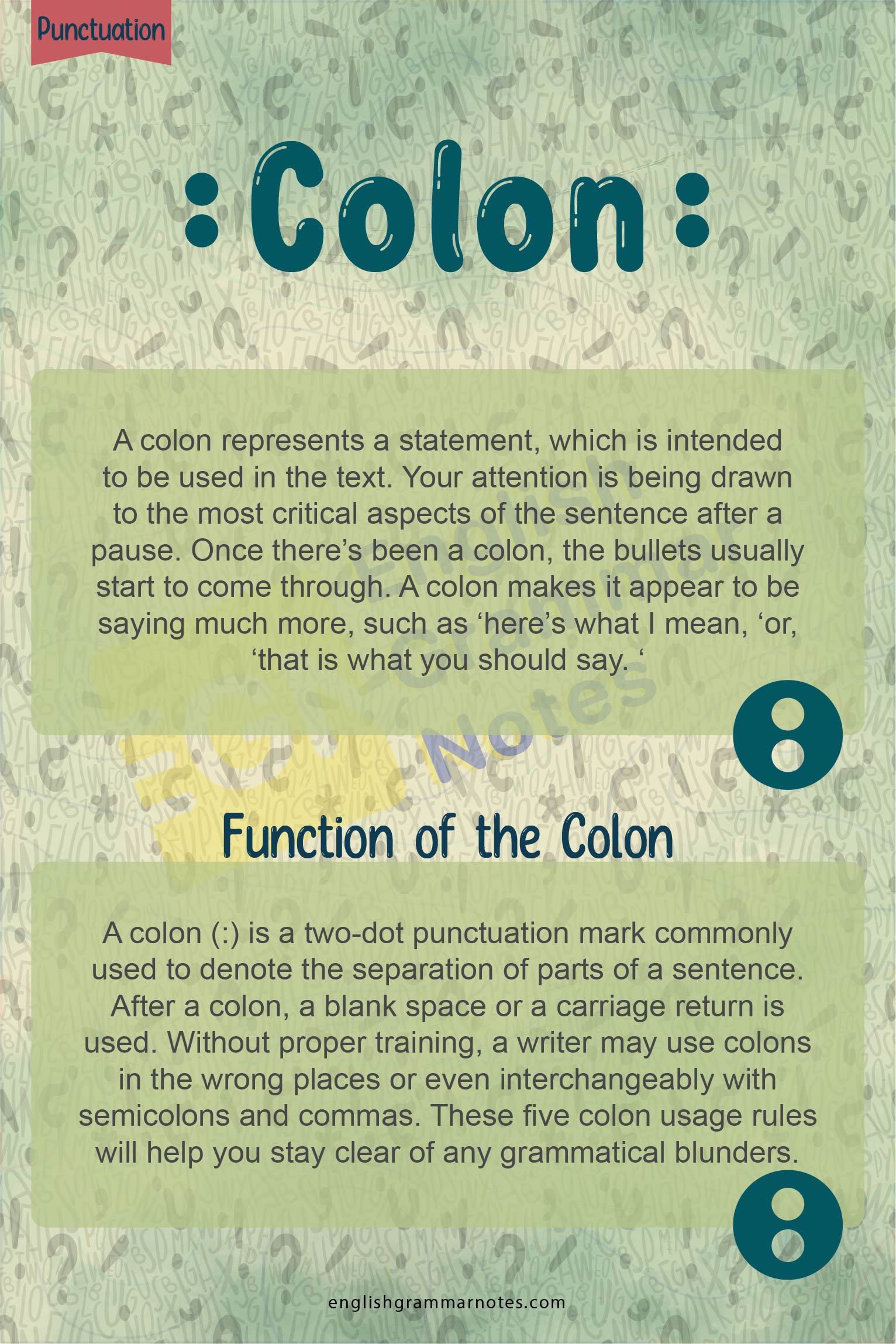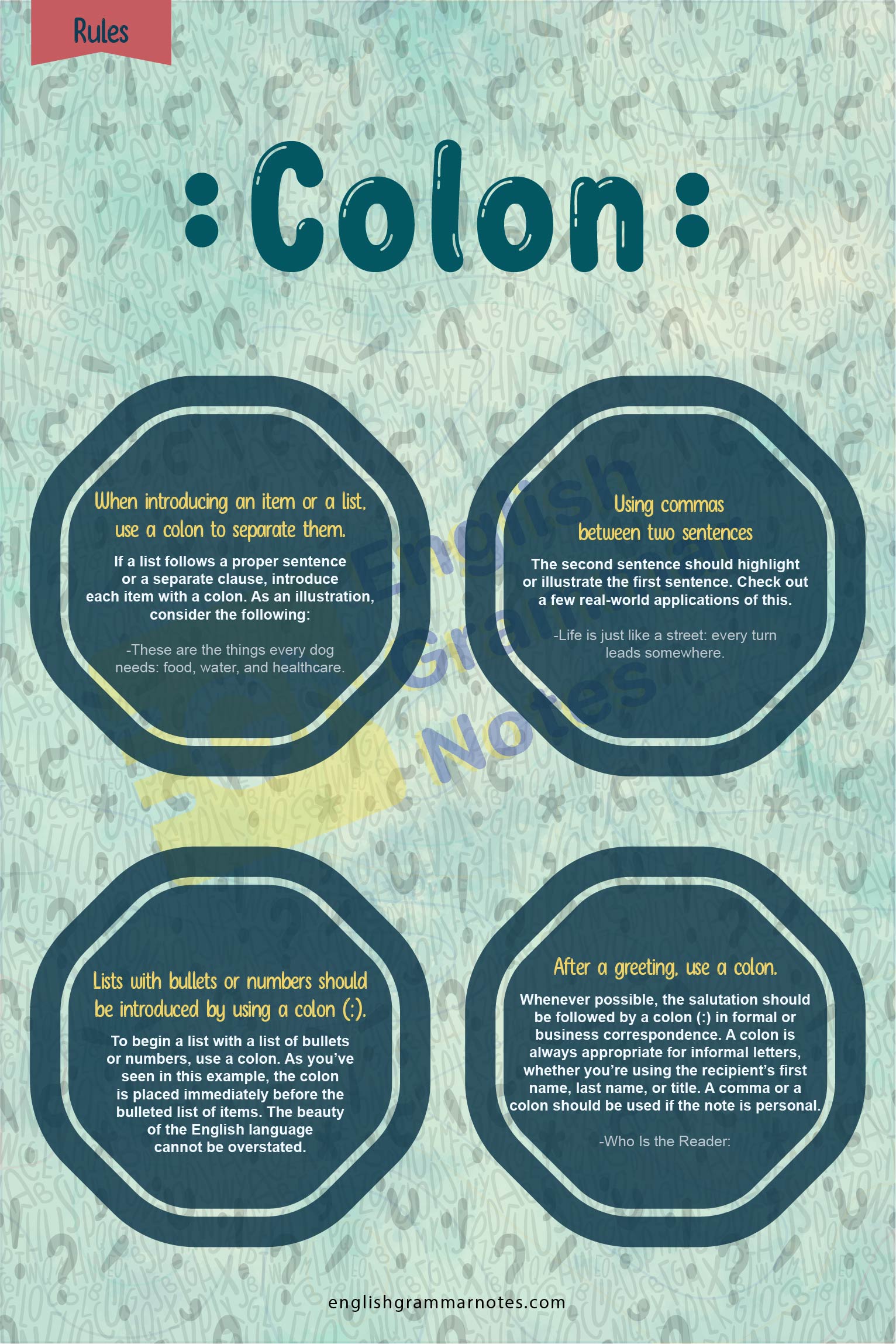Colon: If you want to use a colon instead of another punctuation mark, such as a semicolon, be careful because it can be difficult to distinguish the two effects (;). In reality, Aristophanes was a librarian who came up with a symbol of three dots arranged vertically, which is still used today. For example, each dot on the chart meant something different.
- An end-of-sentence dot was shown at the very top.
- There was no comma before the dot on ‘the ground,’ but there is now (breaking the propositions)
- The line drawn through the middle, with a dot in the middle, represented a rift.
- A period (.) appeared where there should have been a colon (:) and two dots instead of just one.
A colon represents a statement, which is intended to be used in the text. Your attention is being drawn to the most critical aspects of the sentence after a pause. Once there’s been a colon, the bullets usually start to come through. A colon makes it appear to be saying much more, such as ‘here’s what I mean, ‘or, ‘that is what you should say. ‘
If you have information before the colon, a colon involves some degree or sequence of elements to highlight or amplify the information that came before it. If you ordinarily use a semicolon to indicate a close connection between different independent clauses, you can use a colon instead.
What Is the Function of the Colon?
Are you interested in learning more about colons? This is the right place for you. A colon (:) is a two-dot punctuation mark commonly used to denote the separation of parts of a sentence. After a colon, a blank space or a carriage return is used.
A colon can be a problematic punctuation mark to use in a sentence. Without proper training, a writer may use colons in the wrong places or even interchangeably with semicolons and commas. These five colon usage rules will help you stay clear of any grammatical blunders.

Rule 1: When introducing an item or a list, use a colon to separate them.
If a list follows a proper sentence or a separate clause, introduce each item with a colon. As an illustration, consider the following:
- These are the things every dog needs: food, water, and healthcare.
- You’ll need the following items for your laundry: washing detergent, fabric conditioner, and dryer sheets.
- These things must be packed for the camping trip: clothing, sleeping bags, meals, and cooking utensils and equipment.
Only proper nouns have their first word capitalized.
This year, I’d like to travel to four incredible cities: Paris, England, New Jersey, and Spain.
On the other hand, the colon will not appear after just a verb or preposition if used to separate the subject from the object.
Incorrect: we’ll need: cheese, yoghurt, and fabric conditioner.
Correct: We’ll need cheese, yoghurt, and fabric conditioner.
Rule 2: Using commas between two sentences
The second sentence should highlight or illustrate the first sentence. Check out a few real-world applications of this.
- In retrospect, our trip to England was the most memorable: we visited some of its most stunning locations on the planet.
- Diane earned her degree: she got what she wanted after putting in the time and effort.
- Life is just like a street: every turn leads somewhere.
- There is no doubt about it now: he has been elected president.
When a colon is used in this way, the first letter of the second sentence is lower case letters instead of capital.
Rule 3: Lists with bullets or numbers should be introduced by using a colon (:).
To begin a list with a list of bullets or numbers, use a colon. As you’ve seen in this example, the colon is placed immediately before the bulleted list of items. The beauty of the English language cannot be overstated.
In total, punctuation marks come in 14 varieties:
- The usage of periods
- Questions are placed here to help clarify things.
- Capitalization of exclamation marks
- The comma after each sentence
- Use of the semicolon
- The use of colons
- “Dashes” are used instead of periods.
- Hyphens are used to separate words
- In square brackets
- A set of braces
- A pair of brackets
- Singular and plural apostrophes
- An italicized version of
- Ellipses are used instead of full stops
Bullet points and supporting details do not require capitalization or ending punctuation for isolated words or short phrases.
Rule 4: Introduce Long Quotations with a Colon
Extensive quotations should be introduced with a colon; instead of quotation marks, only one space the quote and indent the text starting from the left-hand column. See how a colon affects the length of a quotation.
- Kaira’s philosophy this way is straightforward. To sum up: We become what we think about.
Persuade yourself that the things you want to come to fruition are already in existence. Do not allow yourself to be distracted by concerns about conditions, constraints, or the possibility that your desires will not materialize. As long as you keep your thoughts and intentions untouched, seeds of manifestation will sprout in the physical realm. When you want to differentiate a full sentence quote, put a colon in front of it.
The quotation begins with a capital letter.
- Diane gave the group the news that dinner was ready: “Everyone, sit down.”
- Everyone in the group yelled: We graduated from high school, into the sky.
Rule 5: After a greeting, use a colon.
Whenever possible, the salutation should be followed by a colon (:) in formal or business correspondence. A colon is always appropriate for informal letters, whether you’re using the recipient’s first name, last name, or title. A comma or a colon should be used if the note is personal.
- Who Is the Reader:
- I’m writing to you, Mr Robinson:
- Professor Jamie Miller:

Use of a Colon: What You Need to Know
As you can see, there aren’t many exceptions to the colon usage rules. It’s essential to remember that a colon isn’t the same as a comma, and the two aren’t equivalent. Take a look at these eight instances where commas were critical to understanding. It’ll assist you in making sense of everything.
How to Make Use of Quotation Marks When Writing in the Colon?
When quotation marks are used with another punctuation mark, the result is always a grammatical error. Except for the quotation marks, nothing else needs to be remembered. Everything down to the colon is included.
For quotations, the colon (:) replaces the period (.) as a suitable punctuation mark. Writers and editors prefer this citation style because it presents well on paper.
As an illustration, consider writing a play’s intercharacter dialogue.
If you want the best results from this punctuation mark, be cautious when using it. It serves a variety of functions, as demonstrated above. However, if you’re using a grammar app to double-check your work, it will instruct you only to use the colon when making a list, not when writing. The punctuation mark will not be allowed if you do not comply with this rule.
Colons Are Being Misused
If you’re using a colon to detach a noun from its verb, make sure it’s between the verb and the object or subject supplement, not between the preposition and the object. Here’s an example of a sentence from above that has been rewritten inaccurately to serve as an illustration.
- Muscles in the body are classified into three types: cardiac, seamless, and skeletal.
By inserting a colon here, you separate the verb be from its complements (cardiac, seamless, and skeletal).
- My dream destinations to visit after graduation are Italy, Israel, and Algeria.
Since the colon differentiates the preposition and its objects, it should be removed (Italy, Israel, and Algeria). The colon needs to be removed for this sentence to be written appropriately.
As a recent college grad, my travel plans include visiting Italy, Israel, and Algeria.
When To Use A Colon In Your Sentence?
Colons can be used in various ways. A few of the uses are mentioned below.
Introducing a list
Colon is mainly used to introduce a list. The colon should only be aligned after independent thought.
Let’s take an example:
My brother played five sports: Cricket, football, basketball, swimming, and soccer.
I had three items on my birthday bucket: a bike, a doll, a ball, and a science book.
To introduce an idea that is the gateway for a reader to go on
Colon is used to introduce a concept that signals the reader or any audience to continue. All the words before a colon entice a reader to expect what will come after the colon.
Let’s take an example:
You only have one option: to keep moving forward.
They knew what they had to do: to win it all.